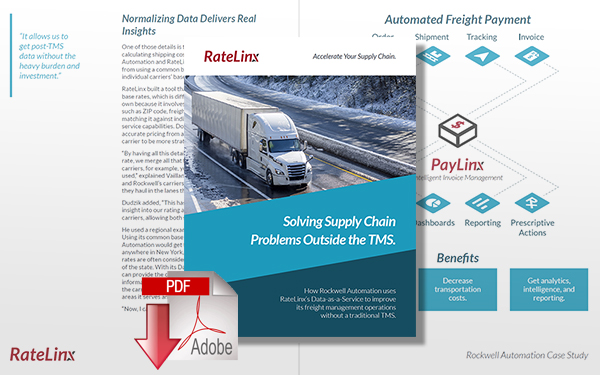How to Augment a Transportation Management System for Supply Chain Intelligence

Replacing a Transportation Management System, TMS, can be costly and ROI elusive, in this article we outline the challenges with implementation and alternatives to consider.
Supply Chain Intelligence
Enhanced supply chain intelligence has become a requirement for shippers to survive and thrive.
However, companies use transportation management systems (TMS) not supportive of today’s automated features like tracking and settlement.
When first introduced, the TMS enabled Tier 1 shippers to optimize shipments.
These complex systems admirably perform many iterations of consolidations and optimizations to find the right combination for the lowest cost to move freight within the timeframe required.
The fundamental purpose of a TMS is to optimize freight and communicate to carriers about their pick-ups and deliveries.
However, these systems are neither flexible nor fast, two essential attributes to compete in today’s quickly changing environment.
Seeking Supply Chain Intelligence
Recently, big data has fueled drastic changes in shipping, providing predictive analytics and supply chain intelligence not available before.
In today’s demanding environment with multi-party data and real-time requirements, companies with a TMS find the systems cannot perform new functions like tracking and automated freight settlement.
Or, the functionality is not fast enough to be useful. Companies with an updated or legacy TMS face painful, time-consuming and expensive upgrades to leverage these new capabilities. They may buy modules from other providers for features like tracking or freight invoice management in the hopes of bolting them together.
Unfortunately, either option may not yield desired results unless the quality of the data is sufficient.
Read: RateLinx ERP, WMS & TMS Data Collection Value Proposition
TMS Upgrades
Companies reliant on manual routing guides or experiencing rapid growth can leverage optimization methods offered by a TMS.
The efficiencies gained via powerful TMS planning enables companies to scale.
While advanced load planning algorithms offer substantial freight savings, obtaining intelligence by upgrading or purchasing a new TMS can be complicated.
Acquisition costs can be very high, with most systems exceeding $1 million.
For global companies or those with many domestic locations, implementation timelines can approach five years. During this period, a company must maintain two different systems. After the new system goes live, disruption continues until the last location is phased in. After all this time and expense, the solution may not provide the expected intelligence.
Incorporating A Bolt-On Application
A bolt-on application may be practical if you do not have expertise in that area. Examples include software handling trade compliance and customs and small parcel manifesting systems. These solutions ensure compliance, so you don’t have to worry.
Many companies skip TMS upgrades due to time and expense instead of opting for a bolt-on application. Soon, they realize it does not provide the desired intelligence, as the data aggregated from their freight-audit provider is siloed and disconnected from the TMS data.
Alternatively, companies look to the TMS as a freight data repository in hopes of obtaining additional functionality, creating an internal IT project and data lake. Often, these projects are time-consuming and expensive. Ultimately, the objective of obtaining the right data for intelligence is unachieved. Without timely standardizing and cleansing, a company can be left drowning in data that only makes sense sometimes and is not reliable for decision-making.
Keep Your TMS And Add Integrated Data
Most of the time, a company wants to upgrade its TMS to take advantage of new features to ultimately save money. The current system is performing well except for this new feature. A company might seek to leverage the existing system with new features and intelligence without unnecessary disruption or expense.
There are data solutions today that can do just that. These solutions augment a company’s TMS and coexist with a company’s current software suite by starting with the data first. The data piece is essential. By integrating data across multiple sources and not merely aggregating data, a company can evaluate what it really needs to obtain the desired intelligence and save the cost of a system upgrade.
Using integrated data allows a company to verify the desired new strategy will work within the company’s current constraints. Constraints to be considered include the amount of time needed to produce the result, the quality of a company’s master data and any rules that a company’s customers may have. Once the new strategy is fully vetted, the strategy can be plugged into a company’s current process to produce the desired results without a large investment or a long timeline.
Tips For Navigating TMS Improvements
Before your organization embarks on a new TMS project, here are some tips to determine your next step in the data journey. We recommend a 3D (diagnose, develop, deploy) approach to improve a customer’s TMS. The first step, using good clean data, is to diagnose the root cause of any issues.
Next, it’s critical to model or simulates the solution using the data to validate any hypothetical changes that have developed that will work with your current TMS. If the solution involves an additive application for the TMS, you should be able to test the strategy before deployment. Then deploy the solution and create the proper metrics to measure solution performance.
In terms of metrics, we recommend measuring the positive and negative. On the negative side, what are the scenarios that will keep you from achieving your desired result? Make sure you have a key performance indicator (KPI) or report to clearly identify it. On the positive side, measure the current transaction against the historical method. Using data to drive decision-making instead of justifying decisions allows you to create long-term value and competitive advantage.
Obtaining new and enhanced intelligence is a priority for competitive organizations, but achieving actionable insights can be elusive and expensive, eliminating return on investment. Don’t fall into the TMS trap.
Remember, there are other data sources that play a role in the bigger picture. Identify your real objective, start with the data, and build a strategy supported and validated by data and clear KPIs. You’ll find real, cost-effective solutions for the next step in your data journey.
This post originally appeared in the Forbes Technology Council blog.
About the Author
Shannon Vaillancourt is president and founder of RateLinx. He started the company in 2002 with the idea that there was a better way to give companies complete visibility to their supply chain. Since then, RateLinx has become a leading supply chain software and data services company with the only integrated Data-as-a-Service (DaaS) technology platform. RateLinx allows companies to gain access to the right data to create a world-class logistics strategy, improve supply chain management, solve problems and reduce costs.
Related Article: 3 Facts Your Supply Chain Track & Trace Visibility Platform is Not Telling You
Related Case Study Paper
Solving Supply Chain Problems Outside the TMS
In this case study paper, we detail how Rockwell Automation uses RateLinx’s Data-as-a-Service to improve its freight management operations without a traditional transportation management system. Download Now!
More from RateLinx
Article Topics
RateLinx News & Resources
Optimizing Parcel Spend with Reveel and Ratelinx Improving Your Logistics Carrier Request for Proposal Process Focusing on Transportation Costs Instead of Manually Resolving Freight Exceptions Improving Customer Service Through Freight Spend Visibility 5 Reasons Your Logistics Cost-Savings Initiatives Are Suffering Integrating Data Streams Improves Retail Supply Chains Using SWOT Analysis to Prepare Your 2020 Supply Chain Technology Strategy More RateLinxLatest in Transportation
Baltimore Opens 45-Foot Deep Channel Following Bridge Collapse El Paso Border Delays Cost Juarez $32 Million Per Day in Economic Losses Ranking the World’s 10 Biggest Supply Chains The Top 10 Risks Facing Supply Chain Professionals Walmart’s Latest Service: Ultra Late-Night Delivery City of Baltimore Files Lawsuit to Recoup Money for Collapsed Bridge The Era of Self-Driving Tractor-Trailers Set to Begin More Transportation














